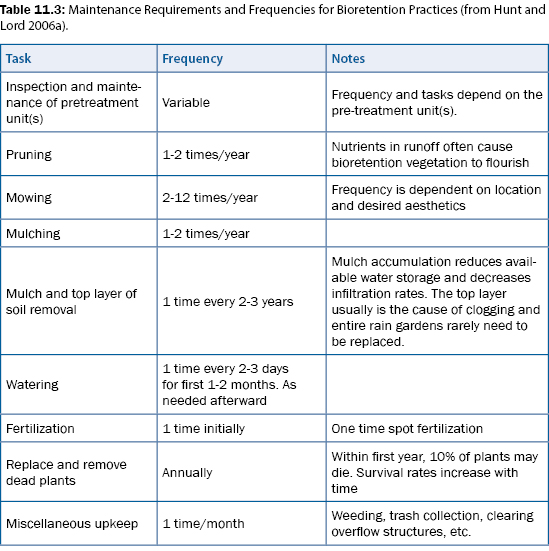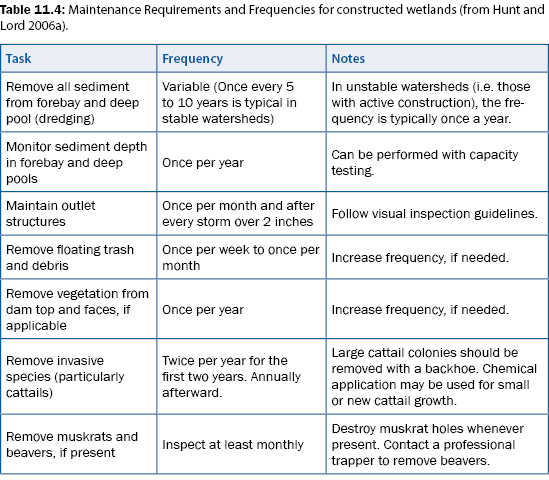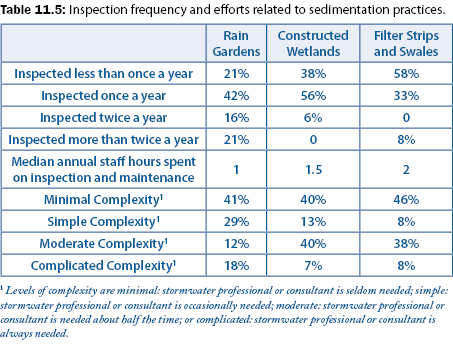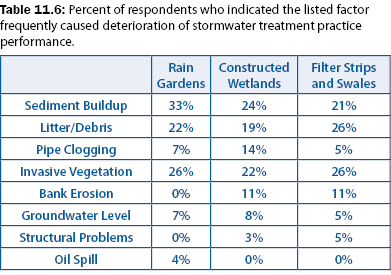
Maintenance for Biologically Enhanced Practices
A.J. Erickson, B.C. Asleson, J.S. Gulliver, R.M. Hozalski
Maintenance of biologically enhanced practices can range from the relatively simple task of trash removal to more complicated tasks such as controlling invasive vegetation and repairing and stabilizing eroded banks. This section is intended to provide information on the maintenance of biologically enhanced practices and factors that typically inhibit performance of the practices.
Actions
Bioretention practices (rain gardens)
Bioretention practices require regular maintenance if they are to remain effective. The required frequency of inspection and maintenance is dependent on the watershed land use (e.g. urban, rural, farm, etc.), construction in the watershed, and rainfall amounts and intensity. It is recommended, however, that visual inspection and any associated maintenance be performed at least once per year. Additional recommended maintenance includes annual inspection for sediment accumulation and removal, if necessary. Hunt and Lord (2006a) discuss the maintenance requirements of bioretention practices (table 11.3).

If any level of assessment reveals that a bioretention practice is not adequately infiltrating runoff, the following steps should be taken.
- Removal of mulch and the top layer of material.
- If the previous step does not correct the situation, the entire practice may need to be replaced.
Constructed wetlands
Constructed wetlands require regular maintenance to remain effective. For example, constructed wetlands can lose their capacity to remove phosphorus over time (Oberts 1999) which may be attributable to vegetation reaching a maximum density (Faulkner and Richardson 1991) or to the soils reaching a maximum sorption capacity. Furthermore, overabundant and decaying vegetation can become a source of soluble and particulate phosphorus that may be released with the effluent. While regularly harvesting wetland vegetation to ‘remove’ phosphorus from the wetland system appears to be the logical solution, research has shown that only minimal amounts of phosphorus are removed when wetland vegetation is harvested (Kadlec and Knight 1996). Eventually, reconstruction may be required for the constructed wetland to remain effective at retaining pollutants. If assessment reveals that existing sediment storage volumes are too large, the stored sediment must be removed from the wetland and disposed of properly. Hunt and Lord (2006b) discuss maintenance requirements for wet ponds and wetlands (table 11.4).

If a constructed wetland is not retaining pollutant at expected levels, the following steps should be taken.
- Check to make sure that the desired levels of pollutant capture are realistic. For example, if the sediment size distribution contains an uncharacteristically large fraction of fines, the hydraulic retention time may not be adequate to achieve the desired retention rate. If retention of the desired pollutant is not realistic, consider implementing another stormwater treatment practice to achieve desired results. Or, if the pollutant is primarily in dissolved form and the vegetation in the wetland is known not to uptake the pollutant at significant levels, it is unrealistic to expect significant levels of retention.
- Perform a sediment capacity test to determine the remaining sediment storage capacity of the wetland. If the storage capacity is exhausted or nearly exhausted, the retained sediment should be removed.
If there is adequate storage capacity remaining in the pond and pollutant removal is still below expected values, a tracer study should be performed to determine if short-circuiting is occurring. If short-circuiting is occurring, consider adding baffles or retrofitting the wetland to redirect the flow of water in a way that minimizes short-circuiting.
Filter strips and swales
Filter strips and swales can retain suspended solids and reduce stormwater runoff volumes through infiltration. The required frequency of inspection and maintenance is dependent on the watershed land use (e.g. urban, rural, farm, etc.), construction practices in the watershed, and rainfall amounts and intensity. It is recommended, however, that visual inspection and any associated maintenance be performed at least once per year.
If infiltration rates or sediment retention rates of a filter strip are unacceptable, the top soil may have to be broken up and the surface reconstructed. Also, enhancing the vegetation can provide benefits by three mechanisms:
- decreasing water velocities which will allow more time for infiltration
- creating more flow paths for the water to infiltrate into the soil
- providing surfaces in the flow to enhance sedimentation.
Finally, decreasing the slope of the filter strip will slow velocities and allow for more sedimentation and more time for infiltration.
Landphair et al. (2000) states that maintenance requirements for roadside swales are minimal other than typical mowing and trash pickup. Immediate replacement of any dead, dying, or missing vegetation, however, is imperative.
Frequency, effort, and cost
Adequate inspection frequency is dependent on many variables including rainfall amount and intensity, watershed use, sediment loads, and many other factors. Survey results (Erickson et al. 2009) indicate that rain gardens and constructed wetlands are most commonly inspected once or more a year while filter strips and swales are most commonly inspected less than once a year. Table 11.5 shows details related to frequency of inspection of biologically enhanced practices. It must be noted that these results are based on the current practice of the municipalities that responded to the survey (Erickson et al. 2009) and the presentation of these results does not imply that the reported maintenance levels and efforts are recommended.

The median annual staff-hours devoted to the inspection and maintenance of biologically enhanced practices is between 1 and 2 hours per year per site, as given in table 11.5.
Municipalities were also asked to gage the level of complexity of their maintenance efforts as minimal, simple, moderate, or complicated (Erickson et al. 2009). These results are also given in Table 11.5 as the percentage of respondents that selected the complexity level. Between 30 and 47% of respondents stated that their maintenance efforts were moderate to complicated, indicating that stormwater professionals were often needed. This is the highest percentage of all groups of stormwater treatment practices.
The U.S. EPA (1999) estimated that typical annual operating and maintenance (O & M) costs for bioretention systems (i.e. rain gardens), as based on expected maintenance schedules, range from 5%-7% of the total construction cost. Weiss et al. (2007) reviewed the literature and found that, based on expected maintenance schedules and estimated prices, the expected annual O & M costs of rain gardens ranged from 0.7%-10.9% of the total construction cost.
For constructed wetlands the corresponding values were 2% (U.S. EPA 1999) and 4%-14.1% (Weiss et al. 2007). For filter strips, expected annual O & M costs were $320 per maintained acre in 1999 (U.S. EPA 1999) with no value being reported by Weiss et al. (2007). Finally, for swales, the U.S. EPA (1999) reported expected annual O & M costs to be 5%-7% of the total construction cost whereas Weiss et al. (2007) found the range to be 4%-178%. It must be noted that these cost estimates are not based on actual O & M cost data but rather typical maintenance schedules and activities combined with the estimated costs to perform these activities.
Factors affecting performance
Survey results (Erickson et al. 2009) indicate that factors that may reduce performance and require maintenance for biologically enhance practices include the presence of retained sediment, trash, invasive vegetation, and other less common factors such as pipe clogging and bank erosion. The percentage of respondents that indicated these and other issues frequently caused deterioration of performance are given in table 11.6. Sediment buildup, invasive vegetation and litter or debris were the primary factors for most of the biologically enhanced practices.

Continue to Recommendations.